Principality of Catalonia
| Principality of Catalonia | |||||||||||||||||||
|---|---|---|---|---|---|---|---|---|---|---|---|---|---|---|---|---|---|---|---|
| 12th century–1714 | |||||||||||||||||||
|
Territory of the Principality of Catalonia until 1659. Location superimposed to current borders | |||||||||||||||||||
| Status |
Realm of the Crown of Aragon (1162–1641, 1652–1714) Realm of the Monarchy of Spain (1516–1641, 1652–1714) Realm of the Monarchy of France (1641–1652) | ||||||||||||||||||
| Capital | Barcelona | ||||||||||||||||||
| Common languages | Catalan, Latin | ||||||||||||||||||
| Religion | Roman Catholicism | ||||||||||||||||||
| Government | Monarchy subject to constitutions | ||||||||||||||||||
| Count | |||||||||||||||||||
• 1162–1196 | Alfons I (first) | ||||||||||||||||||
• 1706–1714 | Charles III (last) | ||||||||||||||||||
| President of the Deputation of the General | |||||||||||||||||||
• 1359–1362 | Berenguer de Cruïlles (first) | ||||||||||||||||||
• 1713–1714 | Josep de Vilamala (last) | ||||||||||||||||||
| Legislature | Catalan Courts | ||||||||||||||||||
| Historical era | Medieval / Early modern | ||||||||||||||||||
• Reign of Alfons I | 1164 –1196 | ||||||||||||||||||
• First Catalan constitutions | 1283 | ||||||||||||||||||
| 1359 | |||||||||||||||||||
• Reign of Charles I | 1516–1556 | ||||||||||||||||||
| 1640–1652 | |||||||||||||||||||
| 1659 | |||||||||||||||||||
| 1701– 1714 | |||||||||||||||||||
| Population | |||||||||||||||||||
• 1700 | 500.000 | ||||||||||||||||||
| Currency | Croat, Ducat, Barcelonian pound, and others | ||||||||||||||||||
| |||||||||||||||||||
| Today part of |
∟ | ||||||||||||||||||
The Principality of Catalonia (Catalan: Principat de Catalunya, Latin: Principatus Cathaloniæ, Occitan: Principautat de Catalonha, French: Principauté de Catalogne, Spanish: Principado de Cataluña) was a medieval and early modern political entity or state in the northeastern Iberian Peninsula. During most of its history it was in dynastic union with the Kingdom of Aragon, constituting together the Crown of Aragon. Between the 13th and the 18th centuries it was bordered by the Kingdom of Aragon to the west, the Kingdom of Valencia to the south, the Kingdom of France and the feudal lordship of Andorra to the north and by the Mediterranean sea to the east. The term "Principality of Catalonia" remained in use until the Second Spanish Republic, when its use declined because of its historical relation to the monarchy. Today, the term Principat (Principality) is used primarily to refer to the autonomous community of Catalonia in Spain, as distinct from the other Catalan Countries.[1][2] and usually including the historical region of Roussillon in southern France.
The first reference to Catalonia and the Catalans appears in the Liber maiolichinus de gestis Pisanorum illustribus, a Pisan chronicle (written between 1117 and 1125) of the conquest of Menorca by a joint force of Italians, Catalans, and Occitans. At the time, Catalonia did not yet exist as a political entity, though the use of this term seems to acknowledge Catalonia as a cultural or geographical entity.
The counties that would eventually make up the Principality of Catalonia were gradually unified under the rule of the Count of Barcelona. In 1137, the County of Barcelona and the Kingdom of Aragon were unified under a single dynasty, creating what modern historians call the Crown of Aragon; however, Aragon and Catalonia retained their own political structure and legal traditions, developing separate political communities along the next centuries. Under Alfons I the Troubador (reigned 1164–1196), Catalonia was regarded as a legal entity for the first time.[3] Still, the term Principality of Catalonia was not used legally until the 14th century, when it was applied to the territories ruled by the Courts of Catalonia.
Its institutional system evolved over the centuries, establishing political bodies (such as the Courts, the Generalitat or the Consell de Cent) and legislation (constitutions, derived from the Usages of Barcelona) which limited the royal power and secured the political model of pactism. Catalonia contributed to further develop the Crown trade and military, most significantly their navy. Catalan language flourished and expanded as more territories were added to the Crown, including Valencia, the Balearic Islands, Sardinia, Sicily, Naples and Athens, constituting a thalassocracy across the Mediterranean. The crisis of the 14th century, the end of the rule of House of Barcelona (1410) and a civil war (1462–1472) weakened the role of the Principality in Crown and international affairs.
The marriage of Ferdinand II of Aragon and Isabella I of Castile in 1469 laid the foundations of the Monarchy of Spain. In 1492 the Spanish colonization of the Americas began, and political power began to shift away towards Castile. Tensions between Catalan institutions and the Monarchy, alongside the peasants' revolts provoked the Reapers' War (1640–1659). By the Treaty of the Pyrenees the Roussillon was ceded to France. During the War of the Spanish Succession (1701-1714), the Crown of Aragon supported the Archduke Charles of Habsburg. After the surrender of Barcelona in 1714, the king Philip V of Bourbon, inspired by the model of France imposed the abolutism and a unifying administration across Spain, and enacted the Nueva Planta decrees for every realm of the Crown of Aragon, which supressed the main Catalan, Aragonese, Valencian and Majorcan political institutions and rights and merged them into the Crown of Castile as provinces.
History
Origins
Like much of the Mediterranean coast of the Iberian Peninsula, it was colonized by Ancient Greeks, who chose to settle in Roses. Both Greeks and Carthaginians interacted with the main Iberian population. After the Carthaginian defeat, it became, along with the rest of Hispania, a part of the Roman Empire, Tarraco being one of the main Roman posts in the Iberian Peninsula and the capital of the province of Tarraconensis.
The Visigoths ruled after the Western Roman Empire's collapse near the end of the 5th century. Moorish Al-Andalus gained control in the early 8th century, after conquering the Visigothic kingdom in 711–718. After the defeat of Emir Abdul Rahman Al Ghafiqiwas's troops at Tours in 732, the Franks gradually gained control of the former Visigoth territories north of the Pyrenees, which had been captured by the Muslims or had become allied with them, in what is today Catalonia under French administration. In 795, Charlemagne created what came to be known as the Marca Hispanica, a buffer zone beyond the province of Septimania, made up of locally administered separate petty kingdoms which served as a defensive barrier between the Umayyad of Al-Andalus and the Frankish Kingdom.
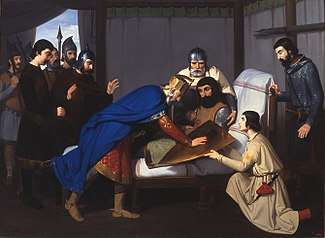
A distinctive Catalan culture started to develop in the Middle Ages stemming from a number of these petty kingdoms organized as small counties throughout the northernmost part of Catalonia. The counts of Barcelona were Frankish vassals nominated by the Carolingian emperor then the king of the Franks, to whom they were feudatories (801–987). During the 9th century, Wifred the Hairy, Count of Barcelona, made its title hereditary and founded the dynasty of the House of Barcelona, which ruled Catalonia until the death of Martin I, its last member, in 1410.
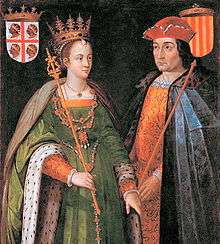
In 987 Count Borrell II did not recognise the Frankish king Hugh Capet and his new dynasty, effectively taking Barcelona out of Frankish rule.[4] During the 9th and 10th centuries, the counties increasingly became a society of aloers, peasant proprietors of small, family-based farms, who lived by subsistence agriculture and owed no formal feudal allegiance. At the start of 11th century the Catalan Counties suffer an important process of feudalisation, as the miles formed links of vassalage over this previously independent peasantry. The middle years of the century were characterized by virulent class warfare. Seigniorial violence was unleashed against the peasants, utilizing new military tactics, based on contracting well armed mercenary soldiers mounted on horses. By the end of the century, most of the aloers had been converted into vassals.[5] During the regency of countess Ermesinde of Carcassonne the disintegration of central power was evident. The response of the Catholic Church to the feudal violence was the establishment of the sagreres around churches and the movement of Peace and Truce of God.[6] The first assembly of Peace and Truce was presided by Abbot Oliba in Toulouges, Roussillon in 1027.
Dynastic union
In 1137 Ramon Berenguer IV, Count of Barcelona, married Petronilla of Aragon, establishing the dynastic union of the County of Barcelona and its dominions with the Kingdom of Aragon, which was to create the Crown of Aragon. The reign of Ramon Berenguer IV saw the Catalan conquest of Lleida and Tortosa.
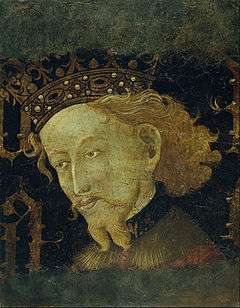
The Battle of Muret (12 September 1213) and the unexpected defeat of King Peter of Aragon and his vassals and allies, the counts of Toulouse, Comminges and Foix, resulted in the fading of the strong human, cultural and economic ties existing between the ancient territories of Catalonia and the Languedoc.
In the Treaty of Corbeil, 1258, James I of Aragon, descendant of Sunifred and Bello of Carcassonne and therefore heir of the House of Barcelona, relinquished his family rights and dominions in the Languedoc and recognized the Capetian king of France Louis IX as heir of the Carolingian Dynasty. In return, the king of France formally renounced his nominal feudal lordship over all the Catalan counties. This treaty turned the de facto independence of the Catalan counties into a full de jure, but meant the irremediable separation between the people of Catalonia and the Languedoc.
As a coastal territory within the Crown of Aragon and with the increasing importance of the port of Barcelona, Catalonia became the main centre of the Crown's maritime power, helping to expand its influence and power by conquest and trade into Valencia, the Balearic Islands, Sardinia and Sicily.
Catalan constitutions (1283–1716) and the 15th century

At the same time, the Principality of Catalonia developed a complex institutional and political system based in the concept of pact between the estates of the realm and the king. The laws (called constitutions) had to be approved in the General Court of Catalonia, one of the first parliamentary bodies of Europe that banned the royal power to create legislation unilaterally (since 1283).[7] The first Catalan constitutions are of the ones from the Catalan Courts (Corts) of Barcelona from 1283. The last ones were promulgated by the Courts of 1705–1706, presided by the disputed king Charles III. The compilations of the Constitutions and other rights of Catalonia followed the Roman tradition of the Codex. This constitutions developed an advanced compilation of rights for the whole citizens of the Principality and limited the power of the kings.

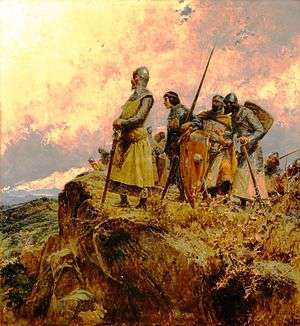
The General Court of Catalonia, dating from the 11th century, is one of the first parliaments in continental Europe. The Courts were composed by the three estates of the realm and were presided by the king of Aragon. The current Parliament of Catalonia is considered the symbolic and historic successor of this institution.
In order to recapt general taxes, the Courts of 1359 established a permanent representation of deputies, called Deputation of the General (in Catalan: Diputació del General) and later usually known as Generalitat, which gained an important political power during the next centuries.
The Principality saw a prosperous period during the 13th century and the beginning of the 14th. The population increased; Catalan language and culture expanded into the islands of the Western Mediterranean. The reign of Peter III of Aragon ("the Great") included the conquest of Sicily and the successful defense against a French crusade; his son and successor Alfonso III ("the Generous") conquered Menorca; and Peter's second son James II conquered Sardinia; Catalonia was the center of the empire. The Catalan Company, mercenaries led by Roger de Flor and formed by Almogavar veterans of the War of the Sicilian Vespers, were hired by the Byzantine Empire to fought the Turks, defeating them in several battles. After the assassination of Roger de Flor by orders of the emperor's son Michael Palaiologos (1305), the Company took revenge sacking Byzantine territory, and they founded the duchies of Athens and Neopatras in the name of the King of Aragon. Catalan rule over the Greek lands lasted until 1390.
This territorial expansion was accompanied by a great development of the Catalan trade, centered in Barcelona, creating an extensive trade network across the Mediterranean which competed with those of the maritime republics of Genoa and Venice. In this line, institutions were created that would give legal protection to merchants, such as the Consulate of the Sea and the Book of the Consulate of the Sea, one of the first compilations of maritime law.
The second quarter of the 14th century saw crucial changes for Catalonia, marked by a succession of natural catastrophes, demographic crises, stagnation and decline in the Catalan economy, and the rise of social tensions. The domains of the Aragonese Crown were severely affected by the Black Death pandemic and by later outbreaks of the plague. Between 1347 and 1497 Catalonia lost 37 percent of its population.[8]
In 1410, King Martin I died without surviving descendants. Under the Compromise of Caspe, Ferdinand from the Castilian House of Trastámara received the Crown of Aragon as Ferdinand I of Aragon. During the reign of John II, social and political tensions caused the Catalan Civil War (1462–1472). From 1493 France formally annexed the counties of Roussillon and Cerdagne, which it had occupied during the conflict. Under his son, Ferdinand II, recovered without war the northern Catalan counties and the Constitució de l'Observança (1481) was approved, establishing the submission of royal power to the laws approved in the Catalan Courts.[9][10] After decades of conflict, the peasants of remença (a mode of serfdom) were liberated from the majority of feudal abuses by the Sentencia Arbitral de Guadalupe (1486).
Catalonia during the early modern period
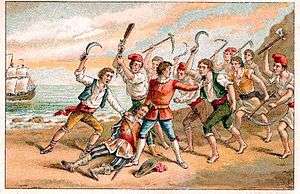
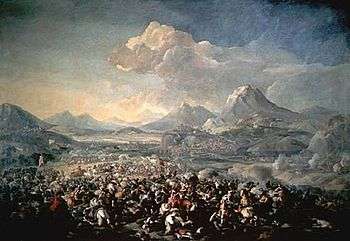
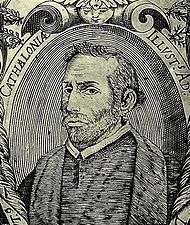
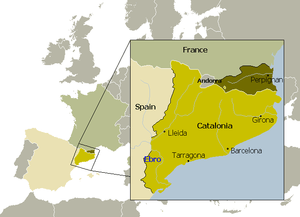
The marriage of Isabella I of Castile and Ferdinand II of Aragon (1469) unified two of the three major Christian kingdoms in the Iberian peninsula, while the Kingdom of Navarre was incorporated later following Ferdinand II's 1512 invasion of the Basque kingdom.
This resulted in the reinforcement of the concept of Spain, which was already present in the mind of these kings,[11] made up by the former Crown of Aragon, Castile, and a Navarre annexed to Castile (1515). In 1492, the last remaining portion of Al-Andalus around Granada was conquered and the Spanish conquest of the Americas began. Political power began to shift away from Aragon toward Castile and, subsequently, from Castile to the Spanish Empire, which engaged in frequent warfare in Europe striving for world domination. In 1516 Charles I of Spain became the first king to rule the Crowns of Castile and Aragon simultaneously by his own right. Following the death of his paternal (House of Habsburg) grandfather, Maximilian I, Holy Roman Emperor, he was also elected Charles V, Holy Roman Emperor, in 1519.[12] The reign of Charles V was a relative harmonious period, during which Catalonia generally accepted the new structure of Spain, despite its own marginalization.
For an extended period, Catalonia, as part of the late Crown of Aragon, continued to retain its own laws and constitutions but these gradually eroded in the course of the transition from a contractual territory to a centralized dominions and the king's struggle to get from the territories as much of the power as possible until they were finally suppressed as a result of the War of the Spanish Succession defeat.
Over the next two centuries, Catalonia was generally on the losing side of a series of wars that led steadily to more centralization of power in Spain. Despite this fact, between the 16th and 18th centuries, the role of the political community in local affairs and the general government of the country was increased, while the royal powers remained relatively restricted, specially after the two last Courts (1701–1702 and 1705–1706). Tensions between the constitutional Catalan institutions and the gradually more centralized Monarchy, alongside other factors such as the economic crisis, the presence of soldiers and the peasants' revolts caused different conflicts, such as the Catalan Revolt, also called Reapers' War (1640–1652), in the context of the Franco-Spanish War, in which Catalonia, led by the president of the Generalitat, Pau Claris, declared itself an independent republic under French protection in 1641, and later again as a principality of the Monarchy of France,[13] but the Catalans were finally defeated and reincorporated into the Crown of Spain in 1652.[14]
In 1659, after the Treaty of the Pyrenees signed by Philip IV of Spain, the comarques (counties) of Roussillon, Conflent, Vallespir and part of la Cerdanya, now known as French Cerdagne, were ceded to France. In recent times, this area has come to be known by nationalist political parties in Catalonia as Northern Catalonia (Roussillon in French), part of the Catalan-spoken territories known as Catalan Countries.
Catalan institutions were suppressed in this part of the territory and public use of Catalan language was prohibited. Currently, this region is administratively part of French Départment of Pyrénées-Orientales.
In the last decades of the 17th century during the reign of Spain's last Habsburg king, Charles II, despite intermittent conflict between Spain and France, the population increased to approximately 500.000 inhabitants[15] and the Catalan economy recovered. This economic growth was boosted by the export of wine to England and the Dutch Republic, this countries were involved in the Nine Years' War against France, as a consequence, there weren't able to trade with French wine. This new trade caused many Catalans to look to England and, especially, the Netherlands as political and economic models for Catalonia.
At the end of the War of the Spanish Succession, in which the Catalans and its army, alongside the other realms of the Crown of Aragon, supported the unsuccessful claim of the Archduke Charles of Austria as Charles III of Spain, the victorious Bourbon Duke of Anjou, now Philip V, occupied the capital of Catalonia after a long siege on 11 September 1714 and in 1716 signed the Nueva Planta decrees, which abolished the Crown of Aragon and all remaining Catalan institutions and laws (except the civil law) and prohibited the administrative use of Catalan language.[16]
After Nueva Planta
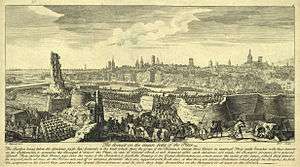
So late as in the 18th and 19th centuries, despite the military occupation, the imposition of high new taxes and the political economy of the House of Bourbon, the Catalonia under Spanish administration (now as a province) continued the process of proto-industrialization, relatively helped at the end of the century from the beginning of open commerce to America and protectionist policies enacted by the Spanish government, becoming a center of Spain's industrialization; to this day it remains one of the most industrialized parts of Spain, along with Madrid and the Basque Country. In 1834, by decree of minister Javier de Burgos, all of Spain was organized into provinces, included Catalonia, which was divided in four provinces without a common administration.
On several occasions during the first third of the 20th century, Catalonia gained and lost varying degrees of autonomy, recovering, after the proclamation of the Second Spanish Republic in 1931, the Generalitat as an institution of self-government, but as in most regions of Spain, Catalan autonomy and culture were crushed to an unprecedented degree after the defeat of the Second Spanish Republic (founded in 1931) in the Spanish Civil War (1936–1939) which brought Francisco Franco to power. Public use of the Catalan language was again banned after a brief period of general recuperation.
The Franco era ended with Franco's death in 1975; in the subsequent Spanish transition to democracy, Catalonia recovered political and cultural autonomy. It became one of the autonomous communities of Spain. In comparison, "Northern Catalonia" in France has no autonomy.
Government and law
Institutions
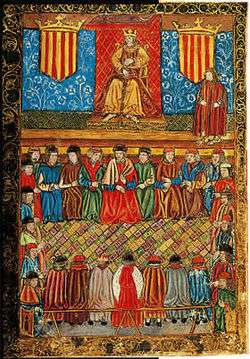
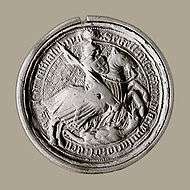
- Cort General de Catalunya or Corts Catalanes (General Court of Catalonia or Catalan Courts): parliamentary body and main institution of the Principality, created during the 13th century. Summoned and presided by the king, it was composed by the three estates of the realm and approved the legislation and the economic donation to the crown. Also served as monarch's council and as a court of justice during the period of sessions.
- Diputació del General or Generalitat de Catalunya (Deputation of the General or Generalitat of Catalonia): permanent council of deputes, created in 1359 by the Courts in order to collect the taxes of the General, and later gained political power and tasks of prosecutor, becoming the most relevant Catalan institution during the early modern age.
- Consell de Cent de Barcelona (Council of One Hundred of Barcelona): institution of government of the city of Barcelona, created during the reign of James I. The municipal authority rested on five, later six, counselors (led by the Conseller en cap, Head Counselor) elected by a Council of hundred individuals (jurats).
- Reial Audiència i Reial Consell de Catalunya (Royal Audience and Royal Council of Catalonia): supreme court of justice of Catalonia and seat of the government. Its members were elected by the king, and it was presided by the Chancellor (Canceller) during the absence of the king and the viceroy.
- Conferència dels Tres Comuns (Conference of the Three Commons): joint meeting of the most dynamic institutions of the Catalan constitutional system during the 17th and 18th centuries, the Deputation of the General, the Military Estate and the Council of One Hundred, in order to discuss the political problems of the Principality.
- Junta de Braços (General Estates): extraordinary council of the Generalitat, composed by some members of the Courts and working like this body, but without formal legislative powers.
- Tribunal de Contrafaccions (Court of Contraventions): court of justice created by the Courts of 1701–1702 in order to ensure the application of the constitutions and solve and prosecute any act (included the ones done by the king or his officers) contrary to the Catalan legislation. Its members were elected in parity by the institutions of the land and the king. It represented an important advance in the guarantee of individual and civil rights, even in the European context.[17]
Legislation
- Usatges de Barcelona (Usages of Barcelona): compilation of customs and legislation based on the Roman and Visigothic law of the County of Barcelona, applied in practice to the entire Principality, that form the basis for the Catalan constitutions.
- Constitucions de Catalunya (Catalan constitutions): laws promulgated by the king and approved by the Catalan Courts. They had pre-eminence over the other legal rules and could only be revoked by the Courts themselves.
- Capítols de Cort (Chapters of Court): laws promulgated by the Courts and approved by the king.
- Actes de Cort (Acts of Court): minor legislative and other rules and decrees promulgated by the Courts, which didn't need the formal approval of the king.
Vegueries

The vegueria was a territorial organization of Catalonia headed by a veguer (Latin: vigerius). The origins of the vegueria go back to the era of the Carolingian Empire, when vicars (Latin: vicarii, singular vicarius) were installed beneath the counts in the Marca Hispanica. The office of a vicar was a vicariate (Latin: vicariatus) and his territory was a vicaria. All these Latin terms of Carolingian administration evolved in the Catalan language.
The veguer was appointed by the king and was accountable to him. He was the military commander of his vegueria (and thus keeper of the publicly owned castles), the chief justice of the same district, and the man in charge of the public finances (the fisc) of the region entrusted to him. As time wore on, the functions of the veguer became more and more judicial in nature. He held a cort (court) del veguer or de la vegueria with its own seal. The cort had authority in all matter save those relating to the feudal aristocracy. It commonly heard pleas of the crown, civil, and criminal cases. The veguer did, however, retain some military functions as well: he was the commander of the militia and the superintendent of royal castles. His job was law and order and the maintenance of the king's peace: in many respects an office analogous to that of the sheriff in England.
Some of the larger vegueries included one or more sotsvegueries (subvigueries), which had a large degree of autonomy. At the end of the twelfth century in Catalonia, there were twelve vegueries. By the end of the reign of Peter the Great (1285) there were seventeen, and by the time of James the Just there were twenty one. After the French annexion of the vegueries of Perpignan and Vilafranca de Conflent in 1659, Catalonia was divided into 15 vegueries, 9 sotsvegueries and the special district of the Val d'Aran. These administrative divisions remained until 1716, when they were replaced by the Castilian corregimientos.
Symbols
As State under royal sovereignty, Catalonia, like the other political entities of the period, didn't have an own flag or coat of arms in the modern sense. However, many royal and other symbols were used in order to identify the Principality and its institutions.
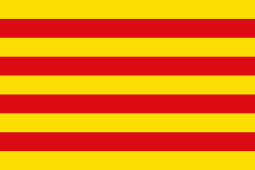 The Senyera is one of the oldest flags in Europe to be used in present-day (but not in continuous use). There are several theories advocating either a Catalan or Aragonese origin for the symbol. It was usually used in the early modern period as the flag that identified the Principality of Catalonia.
The Senyera is one of the oldest flags in Europe to be used in present-day (but not in continuous use). There are several theories advocating either a Catalan or Aragonese origin for the symbol. It was usually used in the early modern period as the flag that identified the Principality of Catalonia..svg.png) Royal arms of the king of Aragon and count of Barcelona until the 16th century.
Royal arms of the king of Aragon and count of Barcelona until the 16th century.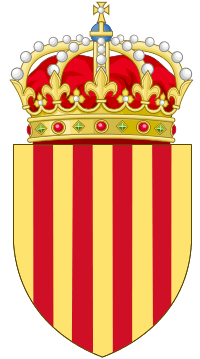 The arms with the Aragonese crown of the early modern period.
The arms with the Aragonese crown of the early modern period.- St George's flag, used by the Deputation of the General or Generalitat and its army.
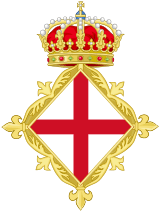 St George Cross as ensign of the Deputation of the General or Generalitat.
St George Cross as ensign of the Deputation of the General or Generalitat.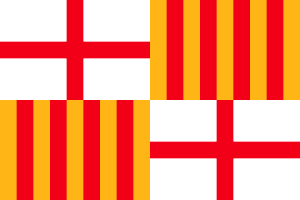 Flag of Barcelona, capital of the Principality, replaced during the last times by the Saint Eulalia's flag. It also appears in some maps as the flag that identified the Principality of Catalonia.
Flag of Barcelona, capital of the Principality, replaced during the last times by the Saint Eulalia's flag. It also appears in some maps as the flag that identified the Principality of Catalonia.
The term Principality
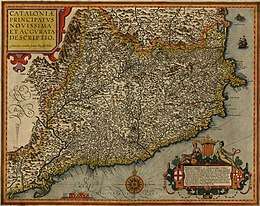
Part of a series on the |
|---|
| History of Catalonia |
 |
|
By topic
|
| Timeline |
|
|
The counts of Barcelona were commonly considered the princeps or primus inter pares ("the first among equals") by the other counts of the Spanish March, both because of their military and economic power, and the supremacy of Barcelona over other cities.
Thus, the Count of Barcelona, Ramon Berenguer I, is called "Prince of Barcelona, Count of Girona and Marchis of Ausona" (princeps Barchinonensis, comes Gerundensis, marchio Ausonensis) in the Act of Consecration of the Cathedral of Barcelona (1058). There are also several references to the Prince in different sections of the Usages of Barcelona, the collection of laws that ruled the county since the early 11th century. Usage #64 calls principatus the group of counties of Barcelona, Girona, and Ausona, all of them under the authority of the count of Barcelona.[18]
The first reference to the Principatus Cathaloniae is found in the convocation of Courts in Perpignan in 1350, presided by the king Peter IV of Aragon and III of Barcelona. It was intended to indicate that the territory under the laws produced by those Courts was not a kingdom, but the enlargement of the territory under the authority of the Count of Barcelona, who was also the king of Aragon, as seen in the "Actas de las cortes generales de la Corona de Aragón 1362–1363".[19] However, there seems to be an older reference, in a more informal context, in Ramon Muntaner's chronicles.
As the Count of Barcelona and the Courts added more counties under his jurisdiction, such as the County of Urgell, the name of "Catalonia", which comprised several counties of different names including the County of Barcelona, was used for the whole. The terms Catalonia and catalans were commonly used to refer to the territory in Northeastern Spain and western Mediterranean France, as well as its inhabitants, and not just the county of Barcelona, at least since the beginnings of the 12th century, as shown in the earliest recordings of these names in the Liber Maiolichinus (around 1117–1125).
In 1931, Republican movements favoured its abandonment because it is historically related to the monarchy.
The name "Principality of Catalonia" is abundant in historical documentation that refers to Catalonia between mid-fourteenth century and early nineteenth century. According to research carried out in recent decades, is considered to be in the second half of the twelfth century when the Catalan counties form a unified and cohesive political entity, -although jurisdictionally divided- called "Catalonia". This happens because the counts of Barcelona became the one hand, the majority of sovereigns Catalan Counties and the other hand kings of Aragon, which helped them prevail in the rest of autonomous Catalan counts (Pallars, Urgell and Empúries) if they were not in their feudal vassals, while also incorporated its extensive domain the Islamic territories of Tortosa and Lleida. The political entity resulting from this process since the thirteenth century, was repeatedly mentioned the term "kingdom" as a medieval state, i.e. public domain political regime monarchist government.
However, it consolidated this denomination officially, because, for various historical reasons, the rulers of the Kingdom of Aragon never uses the title "King of Catalonia." This is where comes in the use of the term "principality", since at least since the twelfth century, the word was synonymous total term "kingdom" which alluded generically political entities which categorize historiographically the expression "Medieval States". Yet it was not until the fourteenth century -specifically, since 1350- that, greetings to work of Peter III of Aragon, the Principality of Catalonia became an official and popular name. This political entity was part of some composite monarchies or dynastic conglomerates as the Crown of Aragon, the Spanish Monarchy and the Kingdom of France (1641–1652), being on an equal footing with other political communities of the time, or external in relation to such great empires, as were the kingdoms of Castile, Aragon, Valencia, England or the Duchy of Milan for to mention a few.
Following the Nueva Planta decrees of 1716 at the end of the War of the Spanish Succession (1701–1714) and the subsequent dismantling of Catalan institutional system, the territory being annexed to Castile became a province of the new and more unified Kingdom of Bourbon Spain, but "principality" continued to be the definition of the territory, as witness the Nueva Planta decrees created the Royal Audience of the Principality of Catalonia in 1716. This situation remained until the Kingdom of Spain was transformed permanently, despite several Carlist Wars, into a liberal state in 1833, when Secretary Javier de Burgos eliminated the province of the Principality of Catalonia, dividing the territory in four provinces that still exist. Thus, the term disappeared from the administrative and political reality of the country.
Neither the Statute of Autonomy of Catalonia, Spanish Constitution nor French Constitution, mention this denomination, but, despite most of them being republican, it is moderately popular among Catalan nationalists and independentists.
Language
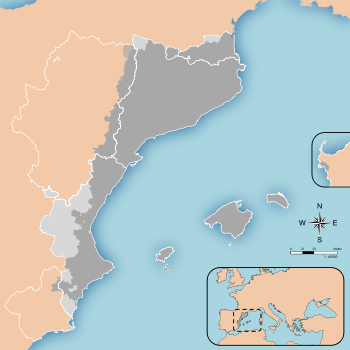
Catalonia constitutes the original nucleus where Catalan is spoken. The Catalan language shares common traits with the Romance languages of Iberia and Gallo-Romance languages of southern France, it is regarded by a minority of linguists as being an Ibero-Romance language (the group that includes Spanish), and by a majority as a Gallo-Romance language, such as French or Occitan from which Catalan diverged between 11th and 14th centuries.[20]
By the 9th century, Catalan had evolved from Vulgar Latin on both sides of the eastern end of the Pyrenees. From the 8th century on, the Catalan counts extended their territory southwards and westwards, conquering territories then occupied by Muslims, bringing their language with them.[21] In the 11th century, feudal documents written in macaronic Latin begin to show Catalan elements. By the end of the 11th century, documents written completely or mostly in Catalan begin to appear, like the Complaints of Guitard Isarn, Lord of Caboet (ca. 1080–1095), or The Oath of peace and truce of count Pere Ramon (1098).[21]
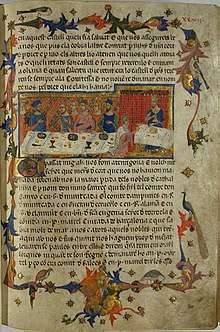
Catalan lived a golden age during the Late Middle Ages, reaching a peak of maturity and cultural plenitude, and expanded territorialy as more lands were added to the dominions of the Crown of Aragon.[21] Examples of this can be seen in the works of Majorcan Ramon Llull (1232–1315), the Four Great Chronicles (13th-14th centuries), and the Valencian school of poetry which culminated in Ausiàs March (1397–1459). Catalan became the language of the Kingdom of Majorca, as well the main language of the Kingdom of Valencia, particularly in coastal areas. It was also extended to Sardinia and it was used as an administrative language in Sicily and Athens. Between the 13th and 15th centuries this language was present all over the Mediterranean world, and it was one of the first basis of the Lingua Franca[22]
The belief that political splendor was correlated with linguistic consolidation was voiced through the Royal Chancery, which promoted a highly standardized language. By the 15th century, the city of Valencia had become the center of social and cultural dynamism. The novel of chivalry Tirant lo Blanc (1490), by Joanot Martorell, shows the transition from medieval to Renaissance values, something than can also be seen in the works of Bernat Metge and Andreu Febrer. During this period, Catalan remained as one of the 'great languages' of medieval Europe. The first book produced with movable type in the Iberian Peninsula was printed in Catalan.
With the union of the crowns of Castille and Aragon (1479), the use of Castilian (Spanish) gradually became more prestigious and marked the start of the relative decline of the Catalan. Along the 16th and 17 centuries, Catalan literature came under the influence of Spanish, and the urban and literary classes became largely bilingual. The defeat of the pro-Habsburg coalition in the War of Spanish Succession (1714) Spanish replaced Catalan in legal documentation, becoming the administrative and political language in the Principality of Catalonia and kingdoms of Valencia and Majorca.
Today, Catalan is one of the three official languages of autonomous community of Catalonia, as stated in the Catalan Statute of Autonomy; the other two are Spanish, and Occitan in its Aranese variety. Catalan has no official recognition in "Northern Catalonia". Catalan has official status alongside Spanish in the Balearic Islands and in the Land of Valencia (where it is called Valencian), as well as Algherese Catalan alongside Italian in the city of Alghero and in Andorra as the sole official language.
Culture
- Traditions of Catalonia
- Category:Catalan culture
- Category:Catalan literature
- Category:Catalan art
See also
References
- ↑ Conversi, Daniele (2014). "Modernity, globalization and nationalism: the age of frenzied boundary-building". In Jackson, Jennifer; Molokotos-Liederman, Lina. Nationalism, Ethnicity and Boundaries: Conceptualising and Understanding Identity Through Boundary Approaches. Routledge. p. 65. ISBN 1317600002. Retrieved 17 June 2017.
- ↑ Conversi, Daniele (2000). The Basques, the Catalans and Spain: Alternative Routes to Nationalist Mobilisation. University of Nevada Press. p. xv. ISBN 0874173620. Retrieved 3 January 2017.
- ↑ Sesma Muñoz, José Angel. La Corona de Aragón. Una introducción crítica. Zaragoza: Caja de la Inmaculada, 2000 (Colección Mariano de Pano y Ruata - Dir. Guillermo Fatás Cabeza). ISBN 84-95306-80-8.
- ↑ Salrach Josep Mª. Catalunya a la fi del primer mil·leni. Pagès Editors, (Lleida, 2004) p. 144–49.
- ↑ Bisson, Thomas Noël. Tormented voices. Power, crisis and humanity in rural Catalonia 1140–1200 (Harvard University Press, 1998)
- ↑ Head, Thomas F.; Landes, Richard Allen (1992). The Peace of God: Social Violence and Religious Response in France Around the Year 1000. Cornell University Press. ISBN 0-8014-8021-3
- ↑ "Las Cortes Catalanas y la primera Generalidad medieval (s. XIII-XIV)". Archived from the original on 19 October 2010. Retrieved 21 January 2013.
- ↑ According to John Huxtable Elliott, "Between 1347 and 1497 the Principality [Catalonia] had lost 37% of its inhabitants, and was reduced to a population of something like 300,000." John Huxtable Elliott (1984). The revolt of the Catalans: a study in the decline of Spain (1598–1640). Cambridge University Press. p. 26. ISBN 0-521-27890-2.
- ↑ Ferro, Víctor: El Dret Públic Català. Les Institucions a Catalunya fins al Decret de Nova Planta; Eumo Editorial; ISBN 84-7602-203-4
- ↑ Palos Peñarroya, Juan Luis: Quin va ser el paper dels juristes catalans en el debat entre absolutisme i constitucionalisme?
- ↑ José Manuel Nieto Soria (2007). "Conceptos de España en tiempos de los Reyes Catolicos" (PDF). Norba. Nueva Revista de Historia. Universidad de Extremadura. 19: 105–123. ISSN 0213-375X.
- ↑ Encyclopædia Britannica online. "Charles V". Retrieved 3 October 2012.
- ↑ Gelderen, Martin van; Skinner, Quentin (2002). Republicanism: Volume 1, Republicanism and Constitutionalism in Early Modern Europe: A Shared European Heritage. Cambridge University Press. p. 284. ISBN 9781139439619
- ↑ Florensa i Soler, Núria (2004). La declinación de la monarquía hispánica en el siglo XVII. Univ. de Castilla La Mancha. ISBN 8484272966.
- ↑ Simon i Tarrés, Antoni. La població catalana a l'epoca moderna. Síntesi i actualització. Barcelona, 1992 p. 217-258 (in Catalan)
- ↑ Mercader, J. Felip V i Catalunya. (Barcelona, 1968)
- ↑ Albareda Salvadó, Joaquim (2010). La Guerra de Sucesión de España (1700–1714). pp. 182–183.
- ↑ See Fita Colomé, Fidel, El principado de Cataluña. Razón de este nombre., Boletín de la Real Academia de la Historia, Vol. 40 (1902), p. 261. (In Spanish)
- ↑ BITECA Manid 2045: Barcelona: Arxiu Corona Aragó, vol. 948
- ↑ Riquer, Martí de, Història de la Literatura Catalana, vol. 1. Barcelona: Edicions Ariel, 1964
- 1 2 3 Costa Carreras 2009, pp. 6–7.
- ↑ La «lingua franca», una revolució lingüística mediterrània amb empremta catalana, Carles Castellanos i Llorenç
Bibliography
- de Tejada y Spínola, Francisco Elías. Las doctrinas políticas en la Cataluña Medieval. Ayma ed. (Barcelona, 1950)
- Vilar, Pierre. La Catalogne dans l'Espagne moderne. Recherches sur les fondements économiques des structures nationales (III vols., Paris, 1962)
- Eliott, John. The revolt of the Catalans: a study in the decline of Spain (1598–1640) (Cambridge University Press, 1963) ISBN 0-521-27890-2
- Serra, Eva. La guerra dels segadors. Ed. Bruguera (Barcelona, 1966)
- Bisson, Thomas Noël. The Medieval Crown of Aragon: a short history (1991) ISBN 0-19-820236-9
- Ferro, Víctor. El Dret Públic Català. Les Institucions a Catalunya fins al Decret de Nova Planta. Ed. Eumo (Vic, 1996) ISBN 84-7602-203-4
- Bisson, Thomas Noël. Tormented voices. Power, crisis and humanity in rural Catalonia 1140–1200. (Harvard University Press, 1998)
- Cingolani, Stefano Maria. Seguir les Vestígies dels Antecessors. Llinatge, Reialesa i Historiografia a Catalunya des de Ramon Berenguer IV a Pere II (1131-1285). Anuario de Estudios Medievales (2006) ISSN 0066-5061
- Torres i Sans, Xavier. Naciones sin nacionalismo. Cataluña en la monarquía hispánica. Publicacions de la Universitat de València (2008) ISBN 978-84-370-7263-0
- Capdeferro, Josep and Serra, Eva. La defensa de les constitucions de Catalunya: el Tribunal de Contrafaccions (1702-1713). Generalitat de Catalunya. Departament de Justícia (2014) ISBN 978-84-393-9203-3